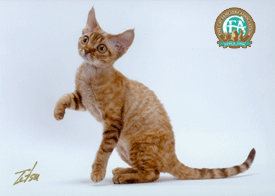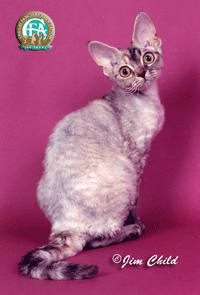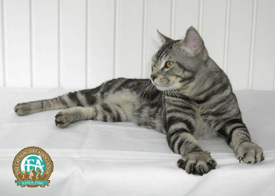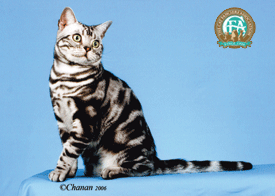


The following information is from the Cat Fancier's Association page on breeds. Text and pictures are copyrighted by the CFA. Layout and font may have changed to fit this page. Images (cat pictures) are copyrighted by the photographer. Please go to the CFA website for details. Enjoy the cats!
Breed Profile: Colorpoint Shorthair
Colorpoint Shorthair
Pictured: Best of Breed GC, BW, RW TEAKATUT'S JORDAN, Seal-Lynx Point Colorpoint Shorthair Male
Photo: © Chanan
Colorpoint Shorthairs are the first cousins of the Siamese. This breed is distinguished by its elegance in sixteen different "point" colors beyond the four Siamese colors. Half-siblings to the Siamese by virtue of their foundation and continuing breeding with the Siamese, the Colorpoint Shorthair is a hybrid breed of the Siamese. Colorpoints, circa 1947-48, are a far cry from their angular, leggy descendants of today. Today's Colorpoints are the same structural standard of the Siamese, with the only difference being their unique point colors.
In the early breedings, breeders concentrated on cats with red or cream restricted to the points (face, legs, ears, tails and genitals). Early hybridizations with domestic shorthairs, and refinement by concentrating the Siamese gene with the red gene, produced the first of the colors to eventually be called Colorpoint Shorthairs. To distinguish the new breed from the Siamese, CFA breeders adopted the name Colorpoint Shorthair for registration purposes, and through a painstaking process won recognition as a breed in 1964. The early cats who helped become the new breed were given the first color class of the Colorpoints, called the solid points, which are the red and cream points.
As time progressed and the early hybrids gained popularity, the tabby versions of the Siamese were introduced into the Colorpoint Shorthair programs in the four Siamese colors. In CFA, these tabby pointed cats are called lynx points and are exhibited in their own "lynx point class" as seal-lynx points, chocolatelynx points, blue-lynx points, lilac-lynx points, red-lynx points and cream-lynx points.
Colorpoint Shorthair
Pictured: Second Best of Breed GC, RW CAPRIOLE MOMENT-OF-ZEN, Seal-Lynx Point Colorpoint Shorthair Female
Photo: © Chanan
The tortie, or parti-colors, are an interesting phenomenon of the hybridization process of the red gene. Shortened to "tortie or cream points," this color class of the Colorpoint Shorthairs are exhibited as the parti-colors. They are memorable representatives of the breed because of their loving yet independent attitudes. The parti-colors are a "by product" of the red gene and come in the four Siamese colors with random mottling or "blotching" of red and/or cream with the basic Siamese color. They often also have what is called a "blaze," a symmetrical split of the red and/or cream on one side of the face mask and the Siamese color, such as seal, on the other half. Indeed, this is a very striking appearance. Because the red color gene is sex linked, tortie or cream parti-color points only come in females. Color descriptions start with the primary Siamese color and add the mottling of red or cream. Thus we have the seal-tortie points, chocolate-tortie points, blue-cream points and lilac-cream points. When bred to a lynx parent, the last four of the sixteen colors are the tabby, or lynx, versions of the parti-color points, i.e. the seal-tortie lynx point, chocolate-tortie lynx point, blue-cream lynx point and lilac-cream lynx point.
Like their Siamese cousins, Colorpoint Shorthairs require little grooming and are especially good in households with allergies to cats since both breeds have little dander. An occasional bath is recommended, but allow the freshly bathed coat to air dry in a warm spot. Do not blow dry, but do brush the coat with the concave or short side of a small rubber brush to remove loose hair and make the coat lie smooth. The coat can be "finished" by smoothing the coat with a chamois cloth. Balanced diets high in protein are generally recommended, since part of the natural beauty of the Colorpoints is their glistening, muscular hard tubular bodies. Heed the instructions of your cat's breeder when you acquire your Colorpoint Shorthair, and you will be blessed with a long-lived joyous companion.
Colorpoint Shorthair
Pictured: Third Best of Breed GC SANLINO BLAZE-OF-GLORY, Seal-Tortie Point Colorpoint Shorthair Female
Photo: © Larry Johnson
Pricing on Colorpoint Shorthairs usually depends on type, applicable markings and bloodlines distinguished by Grand Champion (GC), National, National Breed and/or Regional winning parentage (NW, BW, RW) or of Distinguished Merit parentage (DM). The DM title is achieved by the dam (mother) having produced five CFA grand champion/premier (alter) or DM offspring, or sire (father) having produced fifteen CFA grand champion/premier or DM offspring. Usually breeders make kittens available between twelve and sixteen weeks of age. After twelve weeks, kittens have had their basic inoculations and developed the physical and social stability needed for a new environment, showing, or being transported by air. Keeping such a rare treasure indoors, neutering or spaying and providing acceptable surfaces (e.g. scratching posts) for the natural behavior of scratching (CFA disapproves of declawing or tendonectomy surgery) are essential elements for maintaining a healthy, long and joyful life.
There are CFA clubs devoted to the promotion, protection and preservation of the Colorpoint Shorthair breed. For more information, please send inquiries to CFA, PO Box 1005, Manasquan NJ 08736-0805.
Text: Bernie Hartman
Last Updated: Tuesday, July 17, 2007






































